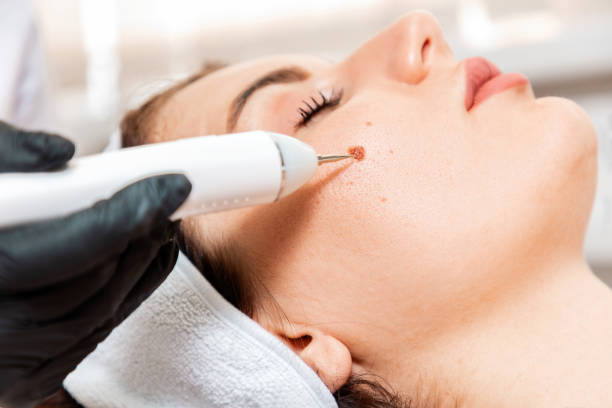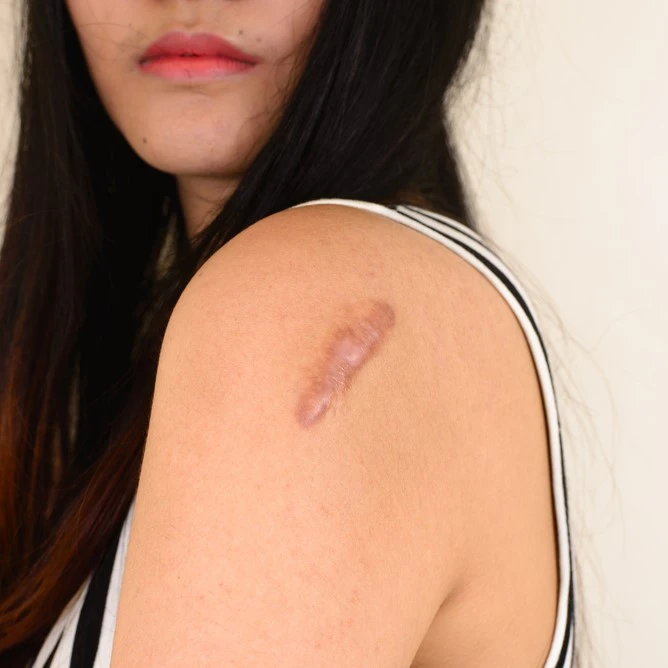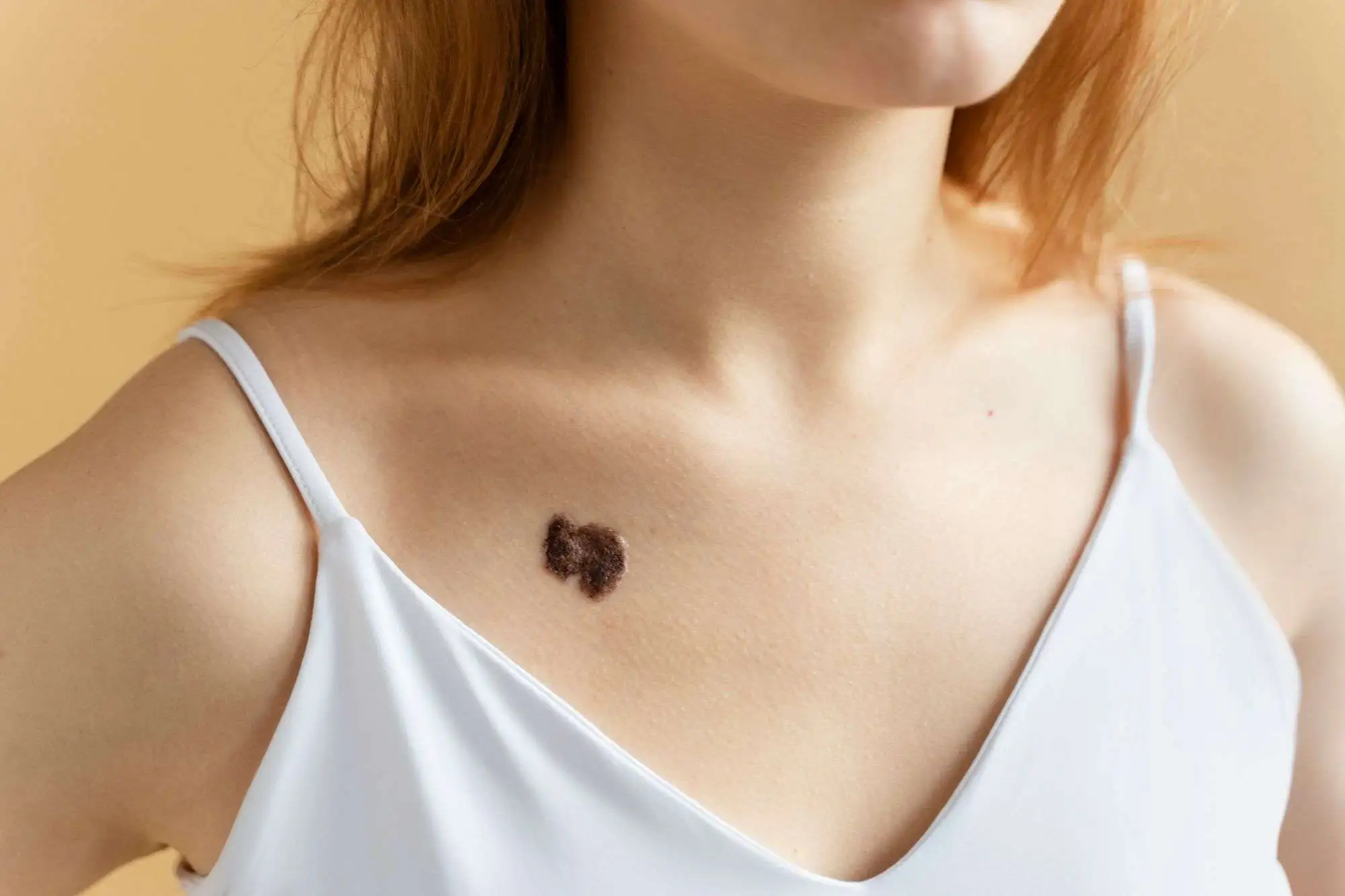Reveal Your True Beauty With
Safe and Effective Mole Removal Services in Riyadh
Embrace Your Look!
Read in Arabic
Are you tired of feeling self-conscious about your moles? Do you have a suspicious-looking mole that’s been causing you worry? If so, mole removal may be the solution you’ve been looking for. Mole removal is a safe and effective medical procedure that can remove unwanted or potentially harmful moles from the skin, leaving you with smoother, blemish-free skin and greater peace of mind. In this article, we’ll dive into the ins and outs of mole removal, including the different methods, the benefits, and what you can expect during and after the procedure. So if you’re considering mole removal service in Riyadh, keep reading to learn more.
Procedure Time
10 Min - 1 Hour
Downtime
Minimal to None
Back to Work
Same Day
Results
Long-lasting
What is Mole Removal?
Mole removal is a medical procedure where a mole, also known as a nevus, is removed from your skin. Moles are a common type of skin growth that can be present from birth or develop over time.
Most moles are harmless, but some may become cancerous, so it’s important to have them checked by a doctor if you notice any changes in size, shape, or color.
The mole removal procedure can be done in different ways, depending on the size, location, and type of mole.
Mole removal is generally a safe procedure, but there may be some risks and potential complications, such as scarring, infection, or bleeding. You should talk to your doctor or dermatologist about the benefits and risks of the procedure before deciding to have it done.
We have history of satisfied patients with the results that we are able to achieve at Enfield Royal Saudia. If you want to know more, get yourself a free consultation.
Who Needs Mole Removal Surgery?
- Mole removal surgery is typically recommended for individuals who have a mole that is causing discomfort, cosmetic concerns, or is potentially cancerous.
- If you have a mole that is constantly irritated by clothing or jewelry, or if it is in a location that makes it prone to bleeding, mole removal surgery may be recommended to alleviate these symptoms.
- Additionally, if you have a mole that has changed in size, shape, or color, or if it has an irregular border or texture, your doctor may recommend mole removal surgery to test for skin cancer.
- In some cases, people may choose to have a mole removed for cosmetic reasons, particularly if the mole is in a prominent location or is causing self-consciousness.
- It’s important to remember that not all moles need to be removed, and the decision to have a mole removed should be made in consultation with a dermatologist or skin specialist. They can evaluate the mole and determine if removal is necessary or if it can be monitored for changes over time.
Why is Mole Removal Done?
Mole removal is done for a variety of reasons. The most common reasons for mole removal are:
- Cosmetic concerns: Some people choose to have a mole removed because they don’t like the way it looks. Moles can be in visible areas like the face or neck, which can affect self-confidence.
- Potential cancerous growths: A mole that has changed in size, shape, color, or texture may be a sign of skin cancer. Removing the mole can prevent cancer from spreading to other parts of the body.
- Discomfort: Moles can be located in areas that cause discomfort or irritation, such as under clothing or jewelry. Removing the mole can alleviate discomfort.
- Biopsy: In some cases, a mole may need to be removed for biopsy, which is a medical test that examines the mole tissue for signs of cancer.
- It’s important to remember that not all moles need to be removed, and the decision to have a mole removed should be made in consultation with a dermatologist or skin specialist. They can evaluate the mole and determine if removal is necessary or if it can be monitored for changes over time.
Your Gateway to Excellence - Book You Mole Removal Appointment Today at Enfield Royal Clinic Saudia!
What Are the Benefits of Mole Removal?
Here are some benefits of mole removal:
- Eliminates potential cancerous growths.
- Provides peace of mind knowing that the mole has been removed and tested.
- Improves appearance and self-confidence by removing a mole that is causing cosmetic concerns.
- Alleviates discomfort or irritation caused by the mole.
- Prevents the mole from getting caught on clothing or jewelry.
- May improve overall skin health by removing a potentially harmful growth.
- Quick and relatively painless procedure with minimal scarring when performed by a skilled dermatologist or skin specialist.
It’s important to note that not all moles need to be removed, and the decision to have a mole removed should be made in consultation with a medical professional. They can evaluate the mole and determine if removal is necessary or if it can be monitored for changes over time.
Procedure of Mole Removal

Mole removal procedures can vary depending on the size, location, and type of mole being removed. Here are some common steps involved in mole removal:
Examination
Before the procedure, a dermatologist or skin specialist will examine the mole to determine if it needs to be removed. They may also take a biopsy of the mole to test for skin cancer.
Preparation
The area around the mole will be cleaned and numbed with a local anesthetic to reduce pain and discomfort during the procedure.
Removal
The mole may be removed using different methods such as:
Shave Excision
A small blade is used to shave off the mole, leaving the skin surface intact. This method is usually used for small and raised moles.
Excision with stitches
A scalpel is used to remove the mole and a small area of surrounding skin. Stitches are then used to close the wound. This method is usually used for larger moles or those with an irregular shape.
Laser Removal
A laser is used to destroy the mole tissue. This method is usually used for flat and pigmented moles.
Post-Treatment
Once the mole has been removed, the area is cleaned and bandaged. In some cases, the removed mole tissue may be sent to a lab for examination to check for skin cancer.
Follow-Up
Your dermatologist or skin specialist will provide you with aftercare instructions, including how to care for the wound and when to remove the bandage. They may also schedule a follow-up appointment to monitor the healing process and check for any signs of infection.
It’s important to note that mole removal procedures are generally safe, but there may be some risks and potential complications, such as scarring, infection, or bleeding. You should talk to your doctor about the benefits and risks of the procedure before deciding to have it done.
Aftercare of Mole Removal
Here are some simple bullet points for aftercare following mole removal:
- Keep the area clean by gently washing it with soap and water and patting it dry.
- Apply an antibiotic ointment to the area as directed by your. dermatologist or skin specialist
- Cover the area with a clean bandage or dressing to protect it from dirt and bacteria.
- Avoid exposing the area to direct sunlight and wear protective clothing or sunscreen with a high SPF when going outdoors.
- Avoid strenuous activities or anything that can cause excessive sweating or friction in the affected area.
- Avoid picking or scratching at the area to prevent infection and scarring.
- Follow your dermatologist or skin specialist’s instructions for any medication or additional treatments that may be necessary.
- Attend all scheduled follow-up appointments to monitor the healing process and check for any signs of infection or complications.
Potential Risks of Mole Removal
Here are some potential risks and complications associated with mole removal:
- Bleeding: It’s common to experience some bleeding during and after the procedure.
- Infection: There is a risk of infection following mole removal, especially if the area is not kept clean and dry.
- Scarring: There is a possibility of scars, depending on the size and location of the mole, as well as the method used for removal.
- Changes in skin sensation: The area around the mole may feel numb or have altered sensation after the procedure, although this usually resolves over time.
- Allergic reaction: Rarely, some individuals may have an allergic reaction to the local anesthetic or other medication used during the procedure.
- Skin discoloration: The skin around the treated area may appear lighter or darker than the surrounding skin, especially if the mole was deeply pigmented.
- Recurrence: In some cases, the mole may grow back if not completely removed, although this is rare.
- It’s important to discuss any potential risks and complications with your dermatologist or skin specialist before undergoing mole removal.
What is the Recovery Time of Mole Removal?
The recovery time for mole removal depends on several factors, including the size and location of the mole, as well as the method used for removal. In general, most people can expect the following:
- Healing time: The healing time for a mole removal can vary from a few days to several weeks, depending on the size and depth of the mole and the method used for removal.
- Pain and discomfort: Some people may experience mild pain, discomfort, or swelling in the area after the procedure. This usually subsides within a few days.
- Scarring: Depending on the location and size of the mole and the method used for removal, scarring may be minimal or more noticeable. It can take several months for the scar to fade.
- Returning to normal activities: Most people can resume their normal activities within a few days to a week after mole removal, depending on the location of the mole and the extent of the procedure.
- It’s important to follow your dermatologist’s or skin specialist’s aftercare instructions to promote proper healing and minimize the risk of complications.
Cost of Mole Removal in Riyadh
Mole Removal
Starting FromMole Removal
StandardThe cost of mole removal in Riyadh can vary depending on several factors, including the size and location of the mole, the method used for removal, and the experience and expertise of the dermatologist or skin specialist performing the procedure.
In general, the cost of mole removal in Riyadh can range from SAR 799 to 1500 SAR. It’s important to consult with a qualified and experienced dermatologist or skin specialist to discuss your individual case and receive an accurate estimate of the cost. Some clinics may also offer packages or discounts for multiple moles or procedures.
Why Choose Us?
At Enfield Royal clinic, we offer top-quality and personalized care for mole removal procedures. Here are a few reasons why you should choose us for your mole removal:
Our dermatologists and skin specialists are highly trained and experienced in mole removal procedures, utilizing the latest techniques and technology to achieve the best possible outcomes.
We understand that every patient is unique, and we take the time to listen to your concerns, answer your questions, and develop a personalized treatment plan that meets your individual needs and goals.
Book Your Appointment!
If you’re considering mole removal service in Riyadh, we invite you to book an appointment with us to discuss your options and learn more about how we can help you achieve your desired results.
FAQs.
TThe amount of pain or discomfort experienced during mole removal varies depending on the size and location of the mole and the method used for removal. Some people may experience mild pain or discomfort during or after the procedure, but this is usually temporary.
Scarring is possible after mole removal, but the extent and visibility of the scar depend on several factors, including the size and location of the mole and the method used for removal. Your dermatologist or skin specialist will discuss the potential for scarring during your consultation.
Moles may be removed for various reasons, including cosmetic concerns, irritation from clothing or jewellery, changes in size, shape, colour, or texture, and the possibility of the mole being cancerous.
Yes, many individuals choose to have moles removed for cosmetic reasons, especially if they are in visible or prominent areas and cause self-consciousness.
While mole removal is generally safe, some potential risks include infection, bleeding, scarring, and an allergic reaction to anaesthesia or other medications used during the procedure.
Relevant Treatments.

Warts Removal
Are you tired of dealing with unsightly warts that just won’t go away? Whether they’re on your hands, feet, or elsewhere on your body, warts can be a frustrating and embarrassing problem. Fortunately, there are a variety of effective wart removal methods available in riyadh that can help you get rid of those pesky growths once and for all.Today, we’ll explore the ins and outs of wart removal, from the different types of warts to the most

Skin Lesion Removal
Discover the path to clear, smooth, and confident skin with Skin Lesion Removal in Riyadh. Whether it’s a bothersome mole, skin tag, or other growth, our skilled surgeons at Enfield Royal Clinic Saudi offer a range of effective treatment methods. Say goodbye to discomfort, enhance your appearance, and experience peace of mind with our personalized care and exceptional results.
Relevant Posts.

Mole Removal Cost in Riyadh
Have you had enough of the bothersome moles on your skin? Do they cause you any discomfort or self-consciousness? This post will help you understand mole removal in Riyadh, including the cost, treatment options, and top clinics. Learn more about Mole Removal Costs in Riyadh. A medical technique called “mole removal” is used to get rid of unsightly moles on the skin. Typical skin growths that can form anywhere on the body are called moles, commonly referred to as nevi.




